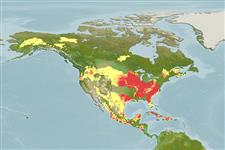Classification / Names
Common names from other countries
Main reference
Size / Weight / Age
Max length : 97.0 cm TL male/unsexed; (Ref. 5723); common length : 40.0 cm TL male/unsexed; (Ref. 556); max. published weight: 10.1 kg (Ref. 4699); max. reported age: 23 years (Ref. 46974)
Environment
Freshwater; benthopelagic; pH range: 7.0 - 7.5; dH range: 10 - ?; depth range ? - 7 m (Ref. 1998)
Climate / Range
Subtropical; 10°C - 32°C (Ref. 12741), preferred ?; 47°N - 26°N
Distribution
North America: St. Lawrence - Great Lakes, Hudson Bay (Red River), and Mississippi River basins; Atlantic drainages from North Carolina to Florida and to northern Mexico. The species has been introduced widely as a game fish and is now cosmopolitan. Several countries report adverse ecological impact after introduction.
Countries | FAO areas | Ecosystems | Occurrences | Introductions
Short description
Dorsal
spines
(total): 10;
Dorsal
soft rays
(total): 11-14;
Anal
spines: 3;
Anal
soft rays: 10 - 12;
Vertebrae: 30 - 32. Mouth large; maxillary extending beyond the eye. Pelvic fins not joined by a membrane. Green to olive dorsally, milk-white to yellow ventrally, with a black band running from the operculum to the base of the caudal fin. Caudal fin rounded. Caudal fin with 17 rays (Ref. 2196).
IUCN Red List Status (Ref. 115185)
Threat to humans
Potential pest
Human uses
Fisheries: minor commercial; aquaculture: commercial; gamefish: yes; aquarium: public aquariums
Tools
Special reports
Download XML
Internet sources
Estimates of some properties based on models
Phylogenetic diversity index
PD50 = 0.5001 many relatives (e.g. carps) 0.5 - 2.0 few relatives (e.g. lungfishes)
Trophic Level
3.8 ±0.4 se; Based on diet studies.
Resilience
Low, minimum population doubling time 4.5 - 14 years (K=0.06-0.14; tm=3-5; tmax=11; Fec=2,000)
Vulnerability
Moderate to high vulnerability (45 of 100)
Price category
